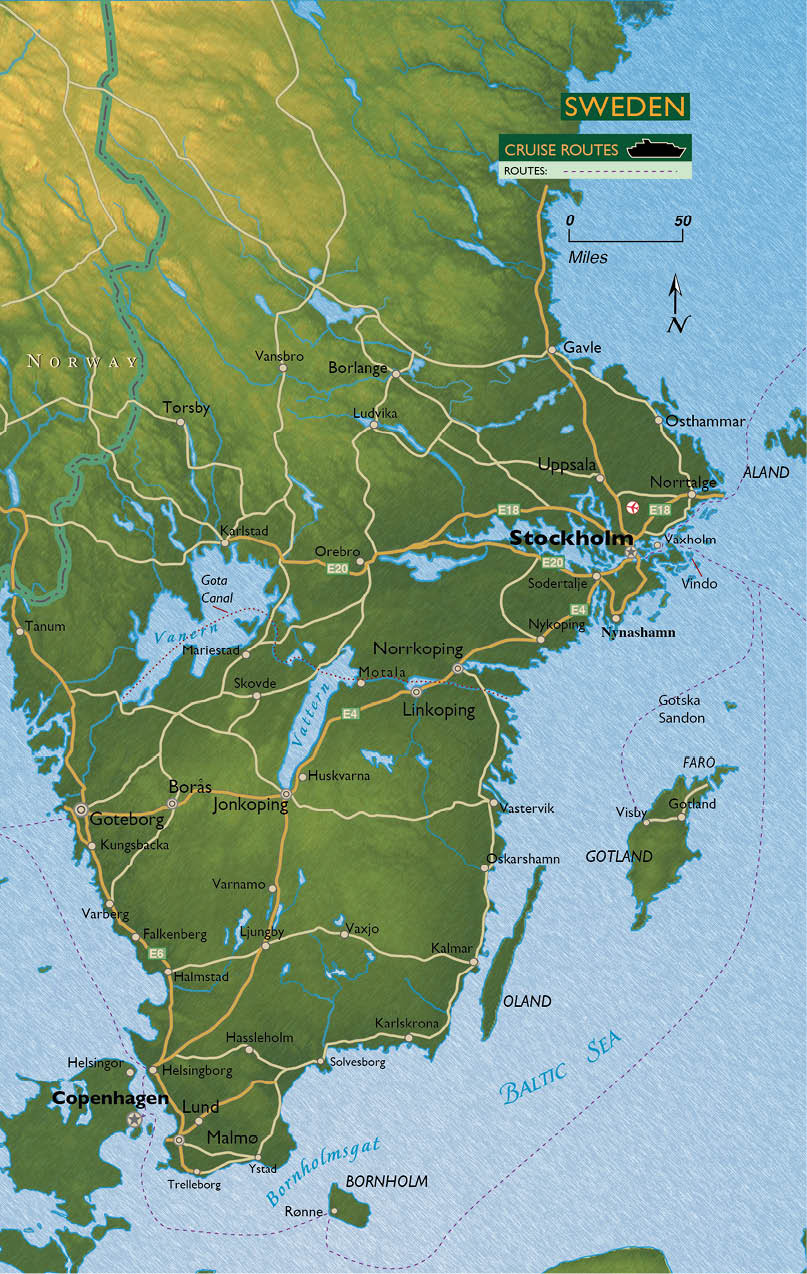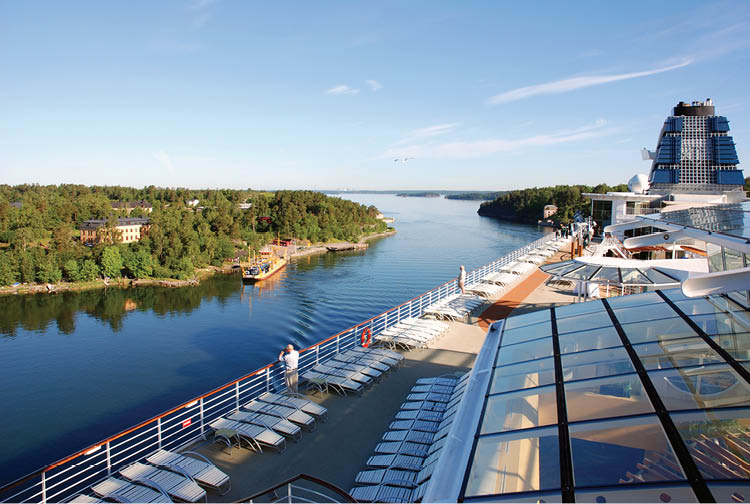Sweden


Pastoral islands dot the waters off Stockholm.
Sweden seems to have it all – beautiful scenery, attractive cities and one of the highest living standards in the world. Universal education and health care are core values and conservation is taken seriously, with the Swedes recycling just about everything and their children raised to be environmentally conscious. Public access to nature is enshrined in the country’s constitution, and this ‘right to roam’ allows hikers to cross private property and even camp there temporarily, providing they ask permission and don’t pitch a tent within sight of someone’s house.
Map of Sweden

Sweden’s longstanding neutrality has placed the country in a unique position as an international mediator and a favoured destination for asylum seekers and refugees – a role Sweden played during World War II when it received children evacuated from Finland and thousands of Jews escaping from Nazi-occupied Denmark and Norway.
The southern one-third of the country is where the majority of Sweden’s 10 million people live. The land here is low-lying and productive for farming, while the northern two-thirds of the country is mountainous and sparsely populated.
Stockholm (pop. 1.4 million) is the capital and largest city. Sweden became a member of the European Union in 1995 but has not joined the single European currency. Sweden’s currency is the Swedish krona (SEK) and 1 krona = 100 ore. The approximate rate of exchange is $1 USD = 8 kronor (£1 = 12 kronor). The euro is not widely accepted.
The official language is Swedish, and English is widely spoken, and the major religion is Lutheranism. The country calling code is +46. Public holidays include National Day (June 6) and Midsummer’s Day (the Saturday that falls between June 20 and 26).

Sweden’s military heritage is reenacted daily in summer at Stockholm’s Royal Palace.
A people called Svear inhabited northern Sweden in early historic times, eventually conquering and merging with their neighbours in southern Sweden. The Swedish kings warred for centuries with the Danes and Norwegians while pushing seaward from their eastern frontier, conquering Finland in the 12th century.
The rise of a feudal class weakened royal authority, as did the influence of German merchants of the Hanseatic League, and in 1397 Sweden became part of the Kalmar Union, instigated by Denmark’s Queen Margrethe. But the Swedes chafed at this arrangement and regents chosen by the Swedish parliament held the real power in Sweden.
When Denmark’s Christian II ordered a massacre of Swedish nobles at Stockholm in 1520, resistance in Sweden hardened. One of the senators killed at the massacre was the father of Gustavus Vasa, who later defeated the Danes and in 1523 was crowned the new king of Sweden, marking the beginning of the Swedish modern state.
Within a century, having seized territory from Russia and Poland, Sweden was the dominant Protestant power of continental Europe under the leadership of the great warrior king Gustavus Adolphus, who died on the battlefield. His daughter Christina made Stockholm the official capital in 1634, reigning over a court filled with music and poetry, attracting scholars such as Descartes.
By the end of the 17th century Sweden had become a European power, controlling Finland, Latvia, Estonia and other parts of the Baltic seaboard. Sweden’s great period of empire came to an end in the Northern War of 1700-1721 when the rising Russian Empire dealt Sweden a crushing defeat. Fraught internally with civil strife and political intrigue, Sweden suffered several coup d’etats as rival factions of the nobility sought power. Gustavus IV was forced to abdicate in 1809 and his aged, childless uncle was placed on the throne while Sweden’s parliament (the Riksdag) searched for a suitable successor. Seeking an alliance with Napoleon, the search ended with the French general Jean Baptiste Jules Bernadotte.
Elected crown prince of Sweden and adopting the name Charles John, Bernadotte was a popular choice with the Swedish public due to the kindness he had shown Swedish prisoners during one of his campaigns. He was also a brilliant military commander who ultimately allied Sweden not with Napoleon but with Russia and England, helping to defeat his former commander at the battle of Leipzig in 1813 and marching the Swedish army into Denmark. This was the last war in which Sweden has participated. Peace prevailed during Bernadotte’s reign as Charles XIV (1814-44) and subsequent kings from the House of Bernadotte oversaw a foreign policy of armed neutrality.
The nation’s current monarch, King Carl XVI Gustaf, serves a ceremonial role, with legislative power vested in the elected Riksdag. The king’s eldest daughter, Crown Princess Victoria, is next in line to the Swedish throne. In 2010, Victoria married her former fitness instructor, Daniel Westing, who grew up in the lake town of Ockelbo, located 100 miles north of Stockholm and far removed from high society. Victoria had to overcome her father’s objections to the match, but in the end true love prevailed and a committee of royal courtiers spent several years tutoring and grooming the friendly country boy into a popular prince.

A ship threads its way through the Stockholm Archipelago.
The approach by ship to Stockholm is one of the most scenic anywhere as your vessel weaves its way past the treed islands of the Stockholm Archipelago. Tens of thousands of islands, islets and skerries comprise this archipelago, and it takes a cruise ship about three hours to navigate through the Northern Stockholm Archipelago. (Some ships instead pull into the port of Nynashamn, located 36 miles south of Stockholm.)
The archipelago’s outer islands are barren rock, but those closer to Stockholm are verdant with trees and gardens. About 150 of these islands are inhabited, their 19th-century mansions and summer cottages overlooking grassy slopes that run down to the water’s edge. A popular recreation area, the islands are connected by waterbus service to Stockholm. In winter the channels freeze over and people ice skate between the islands. They wear extra-long skate blades, use ski poles and carry safety gear in the event they fall through the ice and have to pull themselves out.
Stockholm occupies a cluster of islands where Lake Malaren flows into the Baltic Sea. Founded in the mid-13th century on the site of a fishing village, modern Stockholm is considered one of the world’s finest cities with its broad streets, waterfront parks and well-planned housing projects. The city’s historic core – Gamla Stan (Old Town) – is a medieval warren of narrow, winding streets, and the adjacent island of Sodermalm provided the setting for Stieg Larsson’s Millennium Triology.